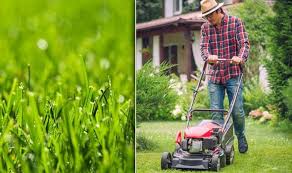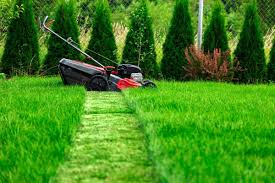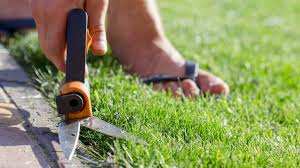When you are cutting grass, you’re doing more than just making your yard look tidy. You’re giving your lawn a chance to stay healthy and inviting. Imagine the smell of grass after it’s freshly cut – it’s like a natural air freshener that brings happiness to your senses.
Cutting grass isn’t just about the action itself. It’s like a special dance between you and your garden. You want to keep the grass at a good height, not too tall and not too short. This way, it can grow sideways and become strong. Think of it as exercise for your lawn!
But wait, there’s more! Cutting grass is actually pretty important for the environment too. It helps stop the soil in your yard from washing away, and it creates a home for tiny insects that are good for your garden. Plus, it makes the air cleaner! And guess what? When you cut the grass, you’re also helping save water. Shorter grass doesn’t let water escape as easily, which means your lawn can drink up more of it.
Now, let’s talk about how to cut grass just right. First, you need the right tools. There are different types of mowers, like the spinning ones and the ones that snip like scissors. Pick the one that works best for you and your yard. And here’s a cool tip: try not to cut more than one-third of the grass at once. It’s like giving your lawn a little haircut, and it feels better when it’s not too short all at once.
Oh, and here’s a secret: change the way you mow every time. Imagine you’re making different patterns on your lawn. This helps keep the soil nice and comfy, and it makes the grass grow evenly.
Now, let’s talk about how short or tall your grass should be. If you want your lawn to look like a soft, green carpet, you can cut it shorter. But if you like a wilder look, a bit taller is better. It’s like choosing a hairstyle for your yard!
So, cutting grass isn’t just a chore. It’s like taking care of a living, breathing part of your home. The smell, the look, and the feel of a well-cut lawn make it all worth it. And remember, when you cut grass, you’re not just helping your yard, you’re helping nature too. So go ahead, grab that mower, and give your grass a trim that’ll make everyone smile.
Read Also: A Guide to Growing and Caring for Bunny Tails Grass (Lagurus Ovatus)
Benefits of Cutting Grass

Here are 7 good benefits of cutting grass:
1. Enhanced Visual Appeal: Regularly cutting grass keeps your lawn looking neat, inviting, and well-groomed, adding to the overall attractiveness of your outdoor space.
2. Promotes Healthy Growth: Cutting grass at the right height encourages lateral growth and results in a thicker, healthier turf that can withstand foot traffic and environmental stress.
3. Prevents Weed Growth: A well-maintained lawn with regularly cut grass reduces open spaces where weeds can take root, naturally minimizing the need for chemical weed control.
4. Supports Water Conservation: Shorter grass helps reduce water evaporation, allowing your lawn to retain moisture more efficiently and conserving water resources.
5. Reduces Pest Habitat: Regular mowing eliminates tall grass where pests might find shelter, helping to keep your lawn and yard free from potential infestations.
6. Prevents Soil Erosion: By maintaining a consistent grass height, you create a protective layer that prevents soil erosion, especially on slopes and areas prone to runoff.
7. Encourages Carbon Sequestration: Healthy grass contributes to carbon sequestration, helping to mitigate the impact of greenhouse gases and promoting a healthier environment.
Cutting grass not only maintains the aesthetics of your lawn but also plays a crucial role in its overall health and the surrounding ecosystem.
Environmental Impact of Cutting Grass

Here are 6 positive environmental impacts of cutting grass:
1. Improved Air Quality: Regularly cutting grass helps release oxygen into the air through photosynthesis, contributing to better air quality and reducing carbon dioxide levels.
2. Carbon Sequestration: Well-maintained grass acts as a natural carbon sink, capturing carbon dioxide from the atmosphere and helping mitigate the effects of climate change.
3. Water Conservation: Shorter grass requires less water as it reduces evaporation, leading to more efficient water usage and contributing to water conservation efforts.
4. Soil Erosion Prevention: Properly maintained lawns with trimmed grass help prevent soil erosion by providing a protective barrier against wind and water runoff.
5. Wildlife Habitat: Regular mowing creates a safe and open space for beneficial insects and small animals, contributing to local biodiversity and supporting a healthy ecosystem.
6. Reduced Heat Island Effect: Shorter grass reflects more sunlight and absorbs less heat, helping to mitigate the urban heat island effect and creating a cooler microclimate.
By considering the environmental impact of cutting grass, you contribute to a greener and more sustainable living environment for yourself and future generations.
Where to Find Cut Grass near Me/You

You can find cut grass around you in the following places:
1. Your Lawn: If you have a lawn or garden, you can easily find cut grass there after mowing.
2. Parks and Recreational Areas: Public parks, playgrounds, and recreational spaces often have areas where grass is regularly mowed and cut.
3. Sports Fields: Sports fields like soccer fields, baseball diamonds, and golf courses regularly cut their grass to maintain a suitable playing surface.
4. School Campuses: Schools and colleges often have lawns and outdoor spaces where grass is maintained.
5. Residential Areas: Some neighborhoods may have common areas or green spaces where grass is cut and maintained.
6. Landscaping Companies: Landscaping and gardening companies may have cut grass as part of their waste disposal.
7. Local Farms: Farms that grow grass for animal feed may also have cut grass available.
8. Community Composting Sites: Some communities have composting sites where residents can drop off yard waste, including cut grass.
Remember, if you’re looking to use cut grass for specific purposes like composting or mulching, make sure it’s free from pesticides and chemicals that might be harmful. Always ask for permission before collecting cut grass from public or private spaces.
Read Also: A Guide to Growing and Caring for Feather Grass (Needle Grass)
Choosing the right equipment for Cutting Grass
When it comes to cutting grass, having the right equipment can make a world of difference in achieving a well-groomed and healthy lawn. Selecting the appropriate mower for your needs and lawn type ensures efficient cutting and a satisfying outdoor experience. Here’s a guide to help you choose the right equipment:
Mower Types
Push Reel Mowers: These traditional mowers are human-powered and have rotating blades that snip the grass like scissors. They’re eco-friendly, quiet, and ideal for small to medium-sized lawns.
Gas-Powered Rotary Mowers: These mowers have a spinning horizontal blade and are suitable for various lawn sizes. They’re versatile, handle rough terrain well, and come in self-propelled or push options.
Electric Mowers: Corded or cordless electric mowers are quieter and emit fewer emissions compared to gas mowers. Cordless models offer more mobility, but consider battery life for larger lawns.
Riding Mowers: Ideal for large lawns, these mowers are like mini-tractors you can ride. They save time and effort but require more storage space and maintenance.
Lawn Size and Terrain
For small lawns: Push reel mowers or electric mowers are efficient and eco-friendly.
For medium lawns: Gas-powered rotary mowers or cordless electric mowers strike a good balance between power and convenience.
For large lawns: Consider riding mowers for time efficiency, especially if your lawn is half an acre or larger.
Budget and Maintenance
Push reel mowers are cost-effective with minimal maintenance, while gas-powered mowers may require more maintenance and fuel costs.
Electric mowers have lower operating costs, but consider battery replacement for cordless models.
Features to Consider
1. Cutting Width: A wider cutting width reduces mowing time, but consider maneuverability in tight spaces.
2. Height Adjustment: Look for easy and precise height adjustments to customize your grass length.
3. Mulching and Bagging: Some mowers offer options to mulch grass clippings back into the lawn or collect them in a bag.
4. Self-Propelled: Self-propelled mowers move forward on their own, reducing effort during mowing.
5. Attachments: Some mowers have attachments like baggers, aerators, or dethatchers for additional lawn care tasks.
Environmental Considerations
Electric mowers are more eco-friendly with lower emissions, but ensure you have access to power outlets or consider battery life.
Reel mowers are the most environmentally friendly option as they produce no emissions.
Before making a decision, assess your lawn’s size, terrain, and your personal preferences.
Research different models, read reviews, and visit local garden centers to see the equipment in person. Choosing the right equipment ensures a pleasant mowing experience and contributes to the overall health and appearance of your lawn.
Read Also: How To Generate Money From Inorganic Wastes
